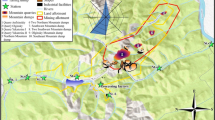Abstract
Metalliferous deposits have played and continue to play a vital role in the economy of South Africa, gold being the most important. The shallow early mines, now abandoned, give rise to subsidence. As a result, the erection of buildings on the undermined land in the old reef area, which runs east to west through the city of Johannesburg, has been controlled by the Government Mining Engineer, including the permissible heights of buildings in relation to the depth of the mining. More recently, the controls have been relaxed when development proposals have been accompanied by sound methods of mine stabilization. Various types of subsidence are discussed, including both the development of sinkholes, which can take place rapidly and have catastrophic results and loss of life, and dolines, associated with dewatering activity. Induced seismicity has also been associated with gold mining. Investigations showed that the seismic events originated near working faces and occurred around the time of blasting. With magnitudes rarely exceeding 3, rarely is there significant surface damage. The conditions in which acid mine drainage related to the oxidation of sulphide minerals develops and the associated problems are also discussed. Case histories are presented to illustrate the environmental problems related directly and indirectly to the mining.
Résumé.
Les gisements métallifères ont joué et continuent de jouer un rôle vital dans l'économie de l'Afrique du Sud, l'or jouant le rôle le plus important. Les premières mines, peu profondes et maintenant abandonnées, donnent lieu à des phénomènes de subsidence. En conséquence, la construction de bâtiments sur des terrains sous-minés dans l'ancienne zone minéralisée qui s'étend d'est en ouest au travers de la ville de Johannesburg, est contrôlée par un service gouvernemental d'ingénierie minière, la hauteur des constructions autorisées étant rapportée à la profondeur des travaux miniers. Plus récemment, les contrôles ont été relâchés alors que les projets de constructions s'accompagnaient de méthodes sûres de stabilisation des anciens travaux miniers.
Plusieurs phénomènes de subsidence sont présentés, incluant les fontis qui peuvent se développer rapidement et conduire à des effets catastrophiques avec pertes de vies humaines, ainsi que les affaissements en rapport avec les activités d'exhaure. Une séismicité induite a aussi été associée à l'exploitation de l'or. Des travaux de recherche ont montré que les événements sismiques étaient produits près des fronts de taille et avaient lieu après les tirs de mines. Leurs magnitudes dépassant rarement 3, les dommages en surface étaient rarement importants. Les conditions dans lesquelles les eaux de drainage s'acidifient, en rapport avec l'oxydation des minéraux sulfurés, sont également discutées. Les études de cas présentées pour illustrer les problèmes environnementaux sont directement ou indirectement en rapport avec l'activité minière.
Similar content being viewed by others
Author information
Authors and Affiliations
Additional information
Electronic Publication
Rights and permissions
About this article
Cite this article
Bell, F.G., De Bruyn, I.A. & Stacey, T.R. Some examples of the impact of metalliferous mining on the environment: a South African perspective. Bull Eng Geol Environ 61, 1–20 (2002). https://doi.org/10.1007/s100640100120
Received:
Accepted:
Published:
Issue Date:
DOI: https://doi.org/10.1007/s100640100120




